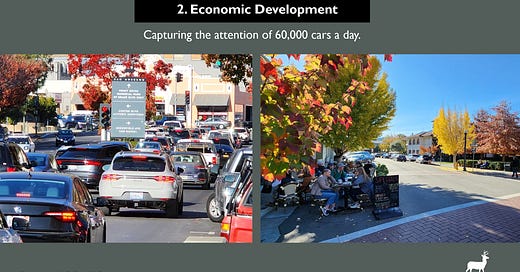Friends - we are coming down the homestretch on the fall semester, and indeed the year.
In Clusters class, there are certain must-cover innovation cluster case studies: Silicon Valley, of course, as both local case study and to define the benchmark; Shenzhen; Hsinchu, Taiwan are among them.
This year we added Israel, which, as a country of just under 10M, was our one national-level case study, and potentially presages additional national-level strategy examples for future classes. (The UK’s Levelling Up initiative is of particular interest. Hat-tip to second-year MBA Alex Morse.)
I was grateful for the energy and preparation of two class members who functioned as simultaneously proud and objective ambassadors during our Israel discussion: Uriel Greenstein and Hezi Cohen, both second-year MBA students. Also, special thanks to second-year MBA Bruno Velloso Rodrigues, who gave a thoughtful readout of the election in Brazil during a prior class.
In Week 13 of Clusters class, we got local - we hosted Brian Colbert, former mayor of San Anselmo, along with Rich Burns of Gnu2 Consulting. Both are also members of the San Anselmo Economic Development Committee. Brian is also current member of San Anselmo city council; and vice-chair of the Board of Commissioners of the Transportation Authority of Marin. The topic of Brian’s talk: could San Anselmo be the next Yountville?
San Anselmo city council member Brian Colbert
This talk built on two prior classes:
Week 2: Silicon Valley (vis-a-vis Boston Route 128)
Week 3: what makes Napa, well, Napa?
The former is, of course, the subject matter of Saxenian’s seminal Regional Advantage. We looked at how Silicon Valley over-indexes relative to its population on certain innovation cluster metrics.
Looking ahead, I may incorporate Chris Miller’s very readable and modular Chip War into future classes.
In looking at Napa, we looked at how Napa defeats the theory of path dependence, and how Napa moved (and stayed) upmarket through human agency and clever competitive positioning vis-a-vis the “incumbent”, i.e., France. In class, we called this the Good Neighbor Theory.
Napa is not a monolith, and within Napa County, the 3000-person town of Yountville has a unique position, with 8 Michelin-ranked restaurants within its confines. It is also home to California’s largest veterans home.
So, can a bedroom town of 12,500 be the Yountville of Marin County? This means something very specific, and has all sorts of implications. Will Marin, for example, get a Culinary Institute equivalent at some point? Will it have the restaurants and hotels - the complementor economy - to justify putting in such a school? Where will service sector staff live? And, from a foodie perspective, which restaurant will be our French Laundry (or my fave, Bistro Jeanty) equivalent?
Marin contains multitudes, from the Canal District to Muir Woods to Point Reyes to bedroom towns like Mill Valley. One thing it doesn’t have a lot of, as Brian observed, is people. County population is all of 260,000, and much of the county is zoned to prohibit development.
This, of course, drives up the price of housing in the remaining areas. We also explored the implications of Prop 13, which froze California property taxes at 1% and limited increases to 2% per year. So while friends in Texas might pay 2% in property tax (plus various fees and tax increment financings) on a marked-to-market basis, a long-time home owner in Marin, who bought in 1979 right after the property tax revolt, is likely paying a couple orders of magnitude less in property tax than someone who newly moved to the area. This leads to very different dependencies and incentives at the state and local levels. California is highly dependent on personal income tax proceeds; Oregon is even more so. Texas, meanwhile, is dependent on property tax and sales tax.
Tax receipts by source: California, Oregon, Pennsylvania and Texas. 2019 data
Brian shared how the city of San Anselmo heavily depends on property tax revenues, which themselves are largely predictable. The city will go to voters directly with bonds and sales taxes as need be. He also shared how the city has branded itself to the traffic that passes through on roads that follow former railway lines.
capture from Brian Colbert guest talk
Suffice it to say, this made for a wonderful, thought-provoking talk, and I am grateful to Brian and Rich for joining us.










